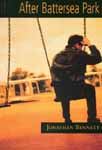 |
After Battersea Park
by Jonathan Bennett
Raincoast Books, 2001
Review by Mark Sampson
Two young men. Twin brothers separated at birth. Thousands of miles apart
and yet sharing a similar life trajectory, a similar need to make sense of
their worlds. Both are artists—one a jazz musician and the other a visual
artist. Both strive to make connections—with women, with careers, with
themselves and with something greater than themselves. Then, after a
ill-timed suicide and a series of near coincidences, the brothers do meet,
and are given the opportunity to come to terms with their pasts and,
consequently, their futures.
In lesser-skilled hands, this scenario would conclude with a kind of
hackneyed happiness, a predictably pat ending where both young men use each
other to “figure out” themselves. But in first-time novelist Jonathan
Bennett’s hands, we’re given something much richer, much truer. After
Battersea Park shows us the indelible struggle between the need for autonomy
and the need to belong to something, and how even after finding something to
belong to, we don’t necessarily solve the problems we face as individuals.
This is a touching, often humourous novel of the young male experience, of
finding connectedness within disconnectedness.
The book’s strongest element is its constant imagery of dualism as brothers
Curt, a struggling jazz musician in Sydney, Australia, and William, a visual
artist in Toronto, claw through life trying to find happiness and success.
Both brothers develop romances with older women as a way of dealing with the
ambiguous relationships with their respective exes. Both work day jobs to
support their art. And both must leave their particular comfort zones—Canada
and Australia—to meet their biological parents on the neutral ground of
Hawaii. Bennett executes this parallel construction beautifully, drawing not
only links between Curt and William but also links between the struggles of
artist expression and facing manhood.
This is also a wonderfully youthful novel, full of basement apartments, day
jobs, dashed idealism and tenuous relationships. Readers in their twenties
(or ones who have survived their twenties) will relate to the unforgiving
ride the two main characters are on. Dealing with dinner dates, infidelity
and eccentric parents adds an insouciant quality to the short, precision
chapters of this book.
After Battersea Park does have its flaws, however. William’s life and
background are better realized than Curt’s, and thus more interesting. There
are times when Bennett’s expression of youthful artistic angst comes off as,
well, youthful artistic angst. Many readers (myself not included) may also
find that the author pushes the “image of dualism” button a little too much,
constantly reminding the reader that the images, the metaphors of the book
are just as “twinned” as the brothers are.
Despite these weaknesses, Bennett shows tremendous control over his
narrative and provides several great themes for readers to explore. The
novel touches on the Canadian and Australian relationship with England and
the United States, a parent-child relationship similar to that of Curt and
William’s relationship with their biological parents. There is also a
commentary on the traditional nuclear family unit here, particularly when
the brothers sit down in a restaurant for their first meal with their
biological parents. The conversation of this piecemeal family, whose lives
could not be any more different or separate, is nearly drowned out by the
banal ramblings of another, far more traditional family sitting at the next
table.
The ending of After Battersea Park is refreshing and unexpected without
being too pessimistic. Ultimately, Curt and William don’t find a whole lot
in each other that says anything about themselves. And yet there is a
wonderful scene near the end where the two men are in a piano bar, working
as a tandem in their respective art forms, Curt playing jazz music on the
piano while William sketches at the table. For one short moment the men are
inseparable, a cohesive unit in a world as fractured as it’s always been. It
may not make you believe in brotherly love, but it will show you how two
things can fit together even when they are so very far apart.
Mark Sampson worked as a journalist and editor in Halifax, Nova Scotia
before moving to Winnipeg in 2000, where he is doing an MA in English
Literature and Creative Writing at the University of Manitoba.
|
